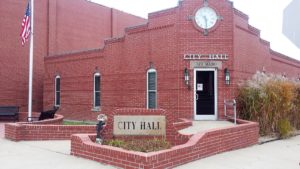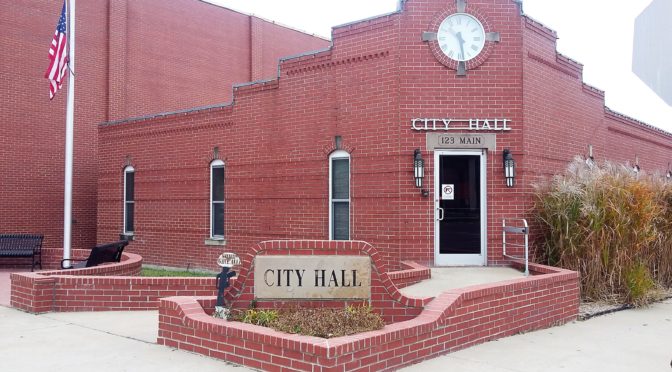
Ft. Scott Community College came to Fort Scott City Commission last week to obtain a letter of support for a house-building grant they are applying for. The application is due February 14, 2025.
Sonia Gugnani, Vice President of Academic Affairs and Rory Chaplain, Associate Dean of CTE and workforce development spoke to the commissioners on Feb. 13 in a special meeting.
Gugnani told the commission that Fort Scott Community College is applying for the Frame grant through the Department of Commerce for community and technical colleges in Kansas. It’s a construction trade grant. The total amount available is $2million, with awards ranging from $250,000 to $1 million per award for those who qualify. This grant is to be used to build 4 houses in the next 2 years, with the first 2 either being renovated or built in the first year and proceeds from the sale of those properties used to build another 2 houses in the next year.
However, the grant money cannot be used buy the land or create the infrastructure needed for the houses.
Gugnani told the commissioners that FSCC wants to collaborate with the city to benefit students and residents of Bourbon County. She asked the city to donate land to build houses on. These houses would be 1100 to 1500 square feet with 3 bedrooms, 2 baths. The Bourbon County Housing Assessment study by Regional Economic Development Inc. (REDI) in 2022 showed there is a need for these kind of houses in Fort Scott.
It would give our students work alongside the contractor and give them an opportunity to give back to their community, said Gugnani.
Chaplain explained that their aim is to build houses in the $185,000 to $225,000 range, so they “feel like it kind of needs to be more of a subdivision, rather than infill,” because the goal is to perpetuate the grant by continuing to build and sell homes. This will give students the ongoing opportunity to learn building skills. Homes must be sold within 180 days of completion.
They are hoping to build a neighborhood, according to Gugnani. The problem with using the renovation option of the grant, is that the department of commerce says they (the homes) must be uninhabitable to qualify.
Commissioner Katheryn Salsbury asked if the school could work with the land bank, which keeps the city from having to build all the infrastructure on a neighborhood plot of land. “It seems to me like that would be a better route,” she said.
Chaplain explained that the issue with using land bank properties is the difficulty of getting a clear title. “The Frame grant allows us to do more, as far as scale. We want to get a bigger return up front before working infill lots.”
Regarding the need to add infrastructure, he said if the land has water and sewer, that could spur on other builds from other contractors.
Gugnani also pointed out that the lots need to be adjacent to facilitate student’s working, as they are bussed over from their schools.
Commissioner Tim Vanhoeke verified that the school does not already have a parcel in mind, and asked how much FSCC is putting into the purchase.
City Manager Brad Matkin explained that the city would purchase the land and gift it to FSCC. As for infrastructure, the city would do it. He said that committing to a certain dollar amount of land purchase money is all the grant application requires.
Commissioner Tracey Dancer said he is not supportive of the city being a land holder or of city tax payers paying to supplement another taxing entity’s acquisition. FSCC already taxes residents of the city and, “the idea that the city tax payers would then pay again, more, to then supplement the community college’s budget. I can’t support it.”
Chaplain responded that FSCC is not asking for more taxes. “The point of the grant is to bolster housing and then also the training for the skills gap…and then also the economic development.”
Gugnani said it’s about whether or not they can include the city’s support in their grant application.
Commissioner Matthew Wells said, “You gotta look at the benefits vs. the cost. One of the benefits that this would bring, specifically to the school, is that if they can get this grant and invest in it now, then in the third and fourth year, they’re going to have the money….this is something that allows them to sow in to doing the land bank properties later.” If they go after the land bank properties right now, they’re not going to make enough of a return to make this particular grant viable for the long-term probability of the program to be able to benefit the city.19:14
Matkin suggested the city buy a 10 acre plot, give 4 to the school to build on and sell the rest to developers to recoup the costs of the city’s initial investment.
Katheryn Salsbury mentioned that at the last city commission meeting they discussed the need for properties in the $60,000-$70,000 range. “I wish that’s what we were doing here….are there enough people in the area who can afford housing these houses that are $125,000 plus?”
Chaplain said that based on housing study and realtors they’ve spoken with, the range they are aiming for is the most popular ask.
Vanhoeke asked what number FSCC wants the city to commit to.
Chaplain replied they are looking at property in the $10,000-$15,000 per acre range.
Matkin said that while the city doesn’t have a 5-10 acre plot within city limits, but there are properties owned by others.
Dancer said he could support working with land bank properties. But reiterated his unwillingness to help another taxing entity (FSCC) by spending taxpayer dollars to buy property.
Matkin replied that FSCC isn’t asking for the city to help them with their budget, they are asking for a grant to give kids the opportunity to build houses. The grant provides material and tools.
Chaplain asked about the city’s economic development dollars.
Dancer said it was already designated. Wells disagreed, saying they had “over $100,000,” and Matkin mentioned land bank money as well.
“We are not looking for 8-10 acres, that was just an idea for the city to recoup the costs,” said Gugnani.
Commissioner Dyllan Olson said the city has to grow. “If your saying investing $100,000 to get more than $2 million in return is a bad investment, I would have to disagree with that.”
Wells pointed out that at the end of the day the city would get 4 taxable properties that would pay back into the city coffers in the form of property taxes for the foreseeable future. He said that by spending $30,000 for 2 acres for the school to build houses on, at current tax rates, the city would recoup their investment in less than 10 years.
Olson said the land bank lacks properties with clear titles that would be viable for the school’s project. Title insurance won’t be available for at least 10 or 15 more years, while the land bank works to clear up the titles.
“We need to make sure were are building the place that we able to sell it so we can recoup the money so that we can continue this project…Building is one part of it. Sustaining is a bigger part of it,” pointed out Gugnani. She said that all the profits of the sale of the houses are rolled into building the next house. FSCC cannot keep any of the money.
Vanhoeke said he was opposed to putting any monetary support in a letter of support from the city.
The City of Fort Scott, REDI, Bourbon County Foundation, and USD234 have all been asked for a letter of support, per Gugnani.
Wells made motion: Because it’s Fort Smith Community College and would provide benefit to our city, provide employees that know how to build, “I’d be willing to offer up at least $30,000 from the economic development fund to be able to purchase land to donate to the school in order to get this program going, just based on the return that we’re going to see.”
Motion was seconded by Olson.
It failed to carry due to Dancer, Vanhoeke, and Salsbury voting against it.
Dancer then made a motion for a letter of the support to include infrastructure, but with no dollar amount or acquisition of property.
Olson asked if the city manager could then look for properties.
Dancer then retracted his motion.
“We have 25 years of not having new housing,” a concerned citizen addressed the commission, saying that the community serious has housing issues and has voiced that they are desperately looking for new housing. “All I ask is that you take the time to consider… that they [community] are looking for some new options to be able to stay here in Ft. Scott. Our population is continually declining. If we don’t make some sort of a move in some direction, I’m afraid that that decline will still continue.”
Salsbury tried to bring the commission to a decision saying they want to support FSCC, but without a dollar amount.
Vanhoeke said dollars should be used to incentivize contractors to rehab or build infills, not fund FSCC’s plan.
Matkin asked what the difference is between giving financial help to a developer (which he predicted would be asked for in a future commission meeting) and buying land for FSCC to build houses on, because it’s a grant they are going after, it’s not benefiting FSCC, but the tax payers by putting houses on the tax rolls.
It’s beneficial to the people who live here and attracting people who commute here. The students who live here in the county, help the community, take pride in it, will be building the houses, pointed out Gugnani.
Wells said there are more than 2,800 commuters to Fort Scott who want to live here, but they want new homes, so they buy them in other cities.
Dancer said that due to the short notice, he is disinclined to commit to support in a monetary amount. “The public has not had a chance to consider this, to contact their representatives…”
Chaplain apologized for the last-minute nature of their meeting, but said regarding helping FSCC and developing housing in Fort Scott, “I don’t think that should be anything new as far as what the idea is.”52:08
Wells made the motion, “that the city write a letter of support saying that we will donate land for the building of the four houses and help with the infrastructure that is needed in order to get the grant.”
Olson seconded.
Dancer wanted to clarify that the city is committing to donate the land by the Aug. 1, 2025 grant start date, “whether we have it currently or not. So sometime in the next 5 months we would have to find the land, or acquire the land, or have it donated.” He expressed concern about urgency driving prices of the land up.
Vanhoeke and Dancer voted no.
Wells and Olson voted yes.
Salsbury broke the tie with her “yes” vote.
